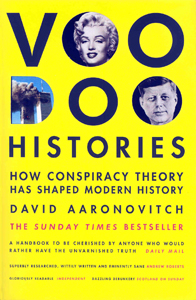What I and reading and doing now (March 2011) Cont…
Holy Blood, Holy Grail, Holy S***! I have just finished Voodoo Histories by David Aaronovitch and this is the title of one of the chapters. Guess what it is about? Of course it is about the book The Holy Blood and the Holy Grail. By Michael Baigent, Richard Leigh and Henry Lincoln published in 1982 (and many times thereafter). As you might imagine  given the discussion in my earlier post about Aaronovitch’s book this chapter is not complimentary about The Holy Blood and the Holy Grail and the sequels The Messianic Legacy and The Temple and the Lodge.
given the discussion in my earlier post about Aaronovitch’s book this chapter is not complimentary about The Holy Blood and the Holy Grail and the sequels The Messianic Legacy and The Temple and the Lodge.
What caught my attention was Aaronovitch’s discussion of this kind of writing in a book about conspiracy theory. His reasons for including this form of writing about the past, known as pseudo-history, and particularly books by these authors is because he sees a pattern common in all conspiracies – that the authorities are dliberately misleading us, the unsuspecting public. In this case the authority in question is the church, that is the Roman Catholic church. For the very few of you who do not already know – what the church does not want us to know (according to these authors) is the fact that Jesus Christ and Mary Magdalene were lovers and had children. After Christ was crucified Mary fled to Gaul (France) with their children. The blood of Christ was then carried from the children of Christ and Mary down to modern times through the Merovingian dynasty, the House of Lorraine and the Knights Templar (to name but a few). Behind them all, watching, waiting, protecting the Holy Blood line is the Priory of Sion. You get the drift.
For me as an historian what is of most interest is Aaronovitch’s examination of the methodology used by the authors. He focuses on an introductory paragraph:
‘It was necessary for us to synthesise in a coherent pattern data extending to from the.. Gospels and Grail romances to accounts of current affairs in modern newspapers… For such an undertaking the techniques of academic scholarship were sorely inadequate. To make the requiste connections between radically diverse bodies of subject matter we were obliged to adopt a more comprehensive approach, based on synthesis rather than conventional analysis.’
In other words the analytical and ‘coventional’ practices of the modern historian are inadequate to the task of linking together such things a: the Bible, Jesus Christ, Holy Grail, Knights Templar, modern newspaper articles and ‘modern thinking’ together to create a cohesive story.
Where Aaronovitch leaves oof I continue. I fail to understand the methodology of such authors not because they fail to say what it is but because they fail to explain the process. They are up front in declaring that they have rejected conventional methods and substituted a comprehensive approach, based on ‘synthesis’ but what does that mean? How is it applied? A ‘comprehensive approach’ suggests that anything and everything can be used but even that possibility is not clear. By not explaining what this methodology actually is, rather than simply providing weighty sounding descriptions, it is impossible to decide if the authors have a methodology at all or are simply making one up. Voodoo Histories argues that the latter is true.
Perhaps those who wish to cling to the mythology created by writers such as these ought not to read Aaronovitch’s book!
Posted in Uncategorized